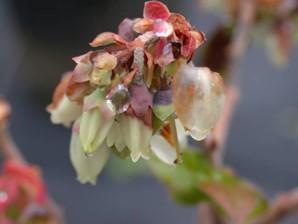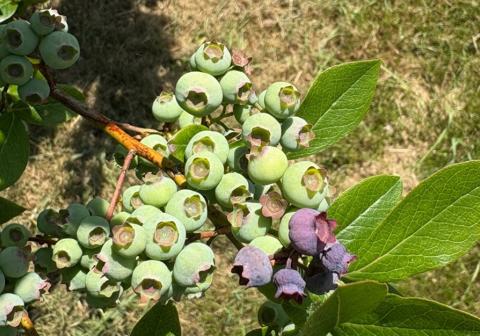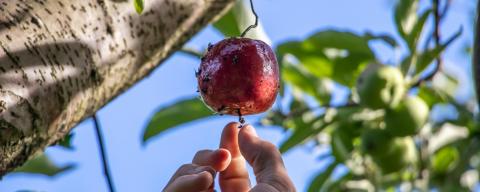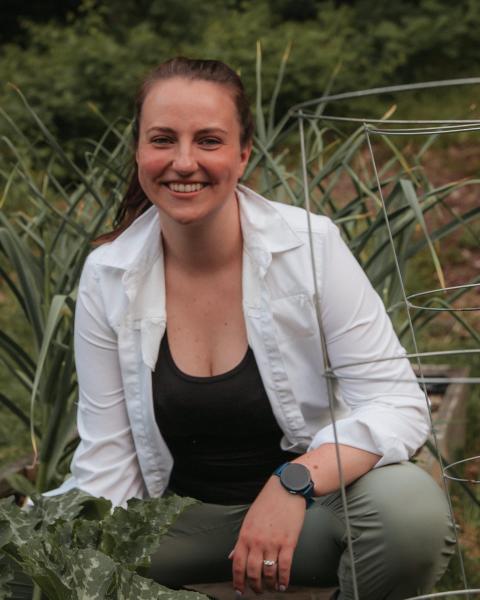Mummy berry, caused by the fungus Monilinia vaccinii-corymbosi, is a significant disease affecting highbush and lowbush blueberries across New Hampshire and the Northeast. This fungal pathogen can cause substantial crop loss if left unmanaged, particularly in cool, wet springs that favor its development.
Description
Mummy berry occurs in two stages. In early spring, mummies that have overwintered on the ground produce cup-shaped structures that release spores for primary infection. These primary infections occur on young shoots and flowers and produce spores that can be carried by pollinating insects to open flowers (Figure 1). The symptoms of these primary infections can sometimes be hard to distinguish from frost injury, shoot blights caused by other fungi, or certain viruses. By blossom time, infected young leaves and shoots wilt, turn brown, and die and can even resemble a shepherd’s crook. These primary infections, which are sometimes referred to as pseudoflowers, are attractive to insect pollinators and produce spores that infect flowers in a similar manner as pollen fertilizing the flower. This results in secondary infections of the fruit, causing the fruit to turn pink, tan, or grey and shrivel into hard mummies (Figure 2). By the end of harvest, mummified fruit have dropped to the ground and become the inoculum for the following year.


Figure 1. Mummy berry leaf blight seen with the pseudoflower and spore production which is caused by the primary infection (first); mummy berry flower bud infection caused by the secondary infection (second). Photo Credit: Peter Oudemans, Rutgers University.

Figure 2. Early stages of mummy berry fruit infection. Photo Credit: Liza DeGenring.
Disease Cycle
The fungi overwinter in mummified fruit on the ground that look like small, black pumpkins (Figure 3). The best location to scout for mummies are in areas of the field that exhibit prolonged wetness. The mummies form cup-shaped structures (apothecia) that release spores beginning around the same time that the new leaves begin to emerge from the buds (Figure 3). Spores are ejected into the air and are carried by wind to young shoots and leaves. This is considered the primary infection.
During the secondary infection, spores (conidia) are spread from the primary infection sites by wind, rain, and bees to blossoms. This results in a secondary infection of the flowers and subsequently the fruit. Fruit that develops from infected flowers turn into mummies and fall to the ground as the inoculum for the following season.
If there is not enough moisture in the spring, the fungus will not produce spores. However, the fungus may survive on the ground in mummies for one year or more.

Figure 3. Mummified fruit on the ground (right) and cup-shaped apothecia (left) that release spores. Photo Credit: Peter Oudemans, Rutgers University.
Management
Cultural Practices:
- Remove mummified berries from the plantings by raking, blowing and collecting, or burying – this will greatly reduce the inoculum present the following year. On a commercial scale or for severe infestations, this may not be practical.
- Add mulch under the bushes to bury the mummified berries – it must be at least 2 inches thick and should be done early in the late winter (mid- to late-February).
- Cultivation in early spring to disturb or cover the mummies has been reported to be effective. This must be done just as the cups (apothecia) start to emerge in the spring but before blueberry bud break.
- Utilization of resistant cultivars can be a viable option. However, varieties differ in their susceptibility to both the shoot blight and the fruit infection. 'Burlington', 'Collins', 'Jersey', 'Darrow', 'Rubel', 'Duke', 'Bluecrop', and 'Bluetta' appear somewhat resistant; 'Earliblue' and 'Blueray' appear more susceptible to mummy berry.
- Monitor mummy berry by using a mummy berry garden/plot or observation station to monitor development under your specific conditions. These plots should be set up in an area away from your planting that will not be disturbed. Directions on how to set up these plots can be found at UMaine or Michigan State University.
- Scouting: scout for the cups (apothecia) in the soil among your plantings. During early to mid-bloom, scout for mummy berry shoot, twig, and leaf blights to determine the risk for secondary infections.
Chemical Control
- Apply fungicides starting at bud break through mid-bloom. If a fungicide is necessary during bloom, it is advisable to spray at night to avoid direct bee exposure to the fungicide spray residues. If there is a history of disease in the planting, and thus an inoculum source, and prolonged cool, wet weather is predicted, a fungicide should be applied. For the most current fungicide recommendations, commercial growers are referred to the New England Small Fruit Management Guide.
Table 1. Summary of key information on Mummy Berry
Summary Table | |
Causal Agent | Fungus |
Major Disease Symptoms | Shoot blight and mummified fruit |
First Noticeable Symptoms | Young shoots and flowers |
Plant Parts Infected | Shoots, young leaves, flowers, and fruit |
Cultural Control | Remove or bury mummified fruit, use resistant cultivars, and use a mummy berry garden |
Spray Program | Protective sprays |
Number of Application per Season | Varies |
Extension Services & Tools That Help NH Farmers Grow
Newsletters: Choose from our many newsletters for production agriculture
Receive Pest Text Alerts - Text UNHIPM to (866) 645-7010


